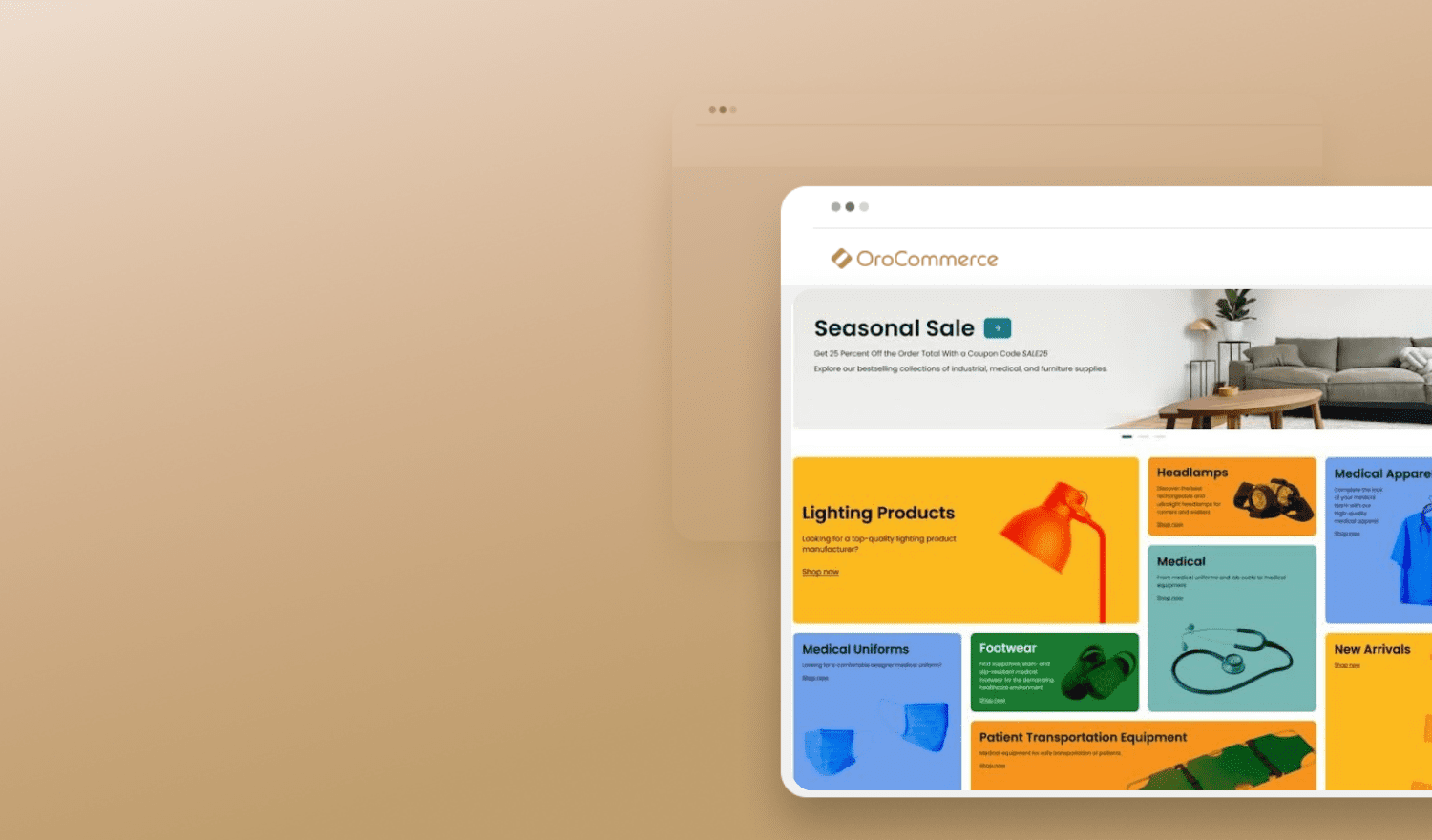navigation

Manufacturers and wholesalers that need to digitize their sales process can be confused by the options. Just because something is a “solution” doesn’t mean it will solve your problem.
We’ve previously looked at eProcurement and punchout catalog solutions to see how they differ from eCommerce systems for B2B companies. Today, we conclude with a comparison of EDI and B2B eCommerce systems.
According to Digital Commerce 360, electronic data interchange is one of the most popular digital sales channels, accounting for more than 75% of digital B2B sales. In comparison, only around 13% of digital sales come from the B2B eCommerce channel.
In this guide, we’ll talk about what makes EDI the go-to approach for business data exchange. We’ll also cover the difference between EDI and eCommerce, the benefits and limitations of each option, and how to know which one is right for you.
What is EDI? The Term’s Definition & Meaning
Electronic Data Interchange (EDI) is a way for computers to transfer documents using predetermined formats and digital rules. It is a direct data transfer between the sending and receiving company. No translators or extra processing is needed.
EDI arose to solve the problem of transferring documents between businesses.
Here’s a simple definition of EDI in eCommerce: If Company A wants to buy or offer their client widgets from Blue Widget Express, both companies are going to create documents that must be shared. Company A will prepare a Purchase Order (PO) to send to Blue Widget Express; Blue Widget Express must then create a Sales Order and Invoice.
When people create documents, errors are bound to occur; if computer programs create the document, the chances for error are dramatically decreased. Besides, computer-to-computer information exchange is much more cost-effective than handling paper documents. Studies have shown that manual processing of paper-based order costs could go as high as $70 while computer processing costs are less than $1.
But computers can only talk to each other when they have a suitable format and architecture. This is where EDI comes into play.
How Does EDI Work?
To define the EDI mechanism in simple terms, let’s look at how it works step by step:
- The two computers must be configured properly for the transfer of data to work correctly using private communication networks.
- EDI data and documents are used to transmit information such as purchase orders, invoices, shipping notices, and remittance letters from one business to another.
- These documents are encrypted and transferred over a secure connection.
- Once received, the data is decrypted and translated into a structured format and components that the receiving system can interpret.
- The data is then integrated into the receiving system, and the process is repeated in reverse to receive data from the other system.

A diagram showing how EDI works
Businesses that want to share documents using EDI must first agree on the implementation of one of several EDI standards. These include ANSI, EDIFACT, TRADACOMS, and ebXML, to name a few.
These standards provide a predetermined format for the information in the document. The larger business usually sets the standards type and is unwilling to modify its EDI terms. This means that smaller businesses must conform to these standards to do business.
However, there are times when an EDI relationship can be highly custom with different pricing, fulfillment terms, and protocols.
So, let us provide a sample use case. From the example above, a Company A employee would prepare a PO using the agreed-upon EDI standard format and then electronically send it to Blue Widget Express. Blue Widget Express would receive the PO, and it would be automatically entered as an order. Because Blue Widget Express isn’t manually entering the order, order entry and other human errors are eliminated.
The order can be filled – with the sales order and invoice generated – and these documents are sent back electronically to Company A using the same predetermined format model. Company A and Blue Widget Express no longer need to use the same software as long as they agree on an EDI standard for sharing business documents.
The Many Flavors of B2B eCommerce
Is EDI Different from eCommerce?
EDI is a way of conducting commerce, and it is electronic, so technically it is eCommerce technology. But it is more about transmitting documents and less about what actually goes into the buying and selling process.
An EDI system is a means of placing orders, while an eCommerce site is a way of not only accepting orders but providing buyers with a complete shopping experience, including a front-end store.
The best way to show the difference between EDI and eCommerce is through an example: if a buyer at Company A knows they need to buy 600 Tiny Aqua Widget SKU 148439 from Blue Widget Express, EDI is a perfect way to place the order.
However, if the buyer isn’t sure what widget they need, or if they need specs on the Tiny Aqua Widget, or if they need to compare the Widget to another widget, access to EDI won’t be of much help.
One way to explain the role of EDI in eCommerce is by looking at the advantages and use cases side-by-side.
EDI vs eCommerce: Main benefits
EDI | eCommerce |
|
|
|
|
|
|
|
|
|
|
EDI vs eCommerce: Use Cases & Functions
EDI | eCommerce |
|
|
|
|
|
|
|
|
EDI and B2B eCommerce: Which Option is Better?
For B2B sellers, EDI and electronic commerce are two ways to accept orders from your existing customers. A sales rep doesn’t need to be available by phone to take the order, customers can order at any hour, it streamlines getting an order into your system, and you don’t need to invest in the technology integration necessary for punchout catalogs. EDI is highly-efficient for customers who knows what they want.
An eCommerce platform enables B2B organizations to reach new markets and expand sales with existing customers. With eCommerce, you can easily upsell and cross-sell to existing customers and try new marketing strategies. You can provide detailed product information for an improved buyer experience.
In addition, product catalogs can be indexed by popular search engines where new buyers can be made aware of your offerings. eCommerce can process new RFQs when EDI works with already established agreements.
While the EDI system in eCommerce and B2B eCommerce streamline the ordering process, only eCommerce can expand your customer base, penetrate new markets, and showcase your brand.
Researching B2B eCommerce vendors?
Download our B2B eCommerce platforms comparison chart
Generally speaking, the EDI application is the best for:
- Transferring large amounts of data quickly and securely.
- Trading with business partners who have standardized or compatible systems in place.
- Ensuring cost-efficiency for high volumes of data transmission.
- Transferring highly structured data such as invoices and purchase orders.
- Automating ordering based on real-time stock levels.
- Complying with supply chain requirements from major retailers and distributors.
On the other hand, B2B eCommerce will be a better option for the following scenarios:
- When you want to educate buyers by displaying a product catalog complete with product information, data sheets, images, videos, etc.
- When you want to provide customers with a self-service option.
- When you want greater integration with existing business processes and systems.
- When you want to have more online visibility.
- When you want to try different selling models and grow sales through cross-selling or upselling.
The downside of relying solely on business-to-business eCommerce is that you could miss out on the advantages of more advanced automation.
Additionally, companies with high-volume orders may be better off with EDI than B2B eCommerce. While B2B eCommerce systems can provide some automation, EDI enables direct computer-to-computer ordering based on inventory levels.
A lot of B2B buyers require their trading partners to have EDI capability, so businesses with an eCommerce-only strategy would have to modify their approach or miss out on the opportunity.
Another important consideration is eCommerce and EDI integration with ERP. Both systems can be integrated with your ERP. Just ensure that the eCommerce or EDI provider you’re considering offers these types of digital integration.
What Strategy is Right for You?
The right strategy is usually a blend of digital solutions, like eCommerce, EDI, and a B2B online portal. If your existing customers rely heavily on their eProcurement systems, it’s possible that EDI or punchout catalogs could simplify the ordering and approval process. But you can’t simply rely on those solutions alone.
A Win-Win: Use EDI in eCommerce for Your Business
To succeed in the digital commerce world, you need to give B2B buyers the online shopping experience they want.
EDI is already the go-to for many B2B transactions, but eCommerce is quickly becoming more popular. If you combine the two, you’ll be able to take advantage of any new opportunities that come your way, while still keeping your costs low.
See first hand how we can help you improve the buying process
Test out the features that matter to you in an interactive demo.
FAQ: Electronic Commerce and Electronic Data Interchange
What is EDI in eCommerce?
EDI (Electronic Data Interchange) is a technology used to electronically exchange business documents (such as purchase orders, invoices, and shipping notices) and electronic media between two or more trading partners.
The major use case of EDI technology in eCommerce involves automating the process of exchanging business documents, reducing the need for manual data entry, and improving accuracy.
How is EDI useful in B2B?
B2B organizations use EDI to increase the speed and accuracy of recurring ordering, so they can collaborate and buy from their partners in a fast and efficient way. It helps achieve better visibility of your inventory, as you know how much your customer will be ordering.
How does EDI differ from B2B eCommerce?
EDI differs from B2B eCommerce in that it’s mostly used for high-volume recurring order processing when the customer knows exactly what they want. EDI helps maintain data quality and integrity, which are important for audit control.
On the other hand, B2B eCommerce business applications help display and market products and communicate with customers in a more interactive way. It’s also useful for the service and communication with small consumers who are unable to do EDI.
Why is EDI important for eCommerce?
The importance of EDI for eCommerce lies in its ability to automate the ordering and procurement process and improve efficiencies across the business. One technology is not necessarily better than the other but they complement each other.



